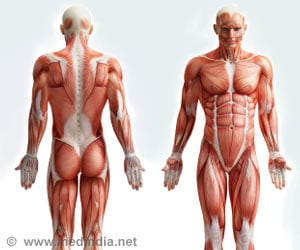A TBP-containing TFIID-protein complex activates genes that regenerate muscle tissue, but an alternative protein called TBP2 is not involved in this task.

‘Muscle stem cells (MuSCs) are adult stem cells present in skeletal muscle tissue that become activated in response to muscle injury to regenerate damaged muscle.’





The research, published in eLife, describes the essential role of a TBP-containing TFIID-protein complex in activating genes that regenerate muscle tissue, and shows that an alternative protein called TBP2 is not involved in this task in adult muscles."Our discovery clarifies the identity of the ‘molecular switches’ that control the activation of muscle genes in muscle stem cells (MuSCs)," said Barbora Malecova, Ph.D., postdoctoral fellow in the laboratory of Pier Lorenzo Puri, M.D., professor in the Development, Aging and Regeneration Program at SBP, and first author of the article. "Understanding what drives muscle gene expression gives us insights into molecular targets for regenerative medicine-based interventions (drugs) to treat muscle degenerative disorders."
MuSCs are adult stem cells present in skeletal muscle tissue that become activated in response to muscle injury to regenerate damaged muscle. In healthy skeletal muscle, MuSCs promote self-healing to repair muscle from normal wear and tear. But in disease conditions like muscular dystrophies, genetic mutations lead to the loss of key structural proteins of muscle cells, which results in cell dysfunction. Cells with these mutations can’t sustain the chronic regeneration pressure imposed by the disease, eventually resulting in progressive muscle weakness and death.
Transcription factors regulate the differentiation or "programming" of MuSCs into mature muscle cells. Targeting transcription factors to activate muscle gene expression is an emerging, promising approach to generate new contractile fibers that counterbalance muscle loss.
"Previous reports had led researchers to believe that a transcription factor called TRF3 (also called TBP2) was absolutely required to activate muscle genes," said Malecova. "Our new study shows that it’s actually a closely related complex called TFIID-TPB that’s key to regenerating muscle. In fact, we show that the TBP2 protein is not even expressed in muscle cells."
Advertisement
"This is an important finding as it resolves a long-standing issue and will prevent researchers from continuing down a path of study unlikely to yield advances in the field," said Puri, senior author of the paper. "Defining the components of the transcription complex that controls the formation of skeletal muscle may help find new treatment options to improve the lives of patients with muscle degenerative disorders."
Advertisement
This research was supported by funding from the National Institutes of Health, the European Research Council, the French Agence nationale de la recherche, the European Union, California Institute for Regenerative Medicine, the Dutch Duchenne Parent Project, the American-Italian Cancer Foundation, and the American Heart Association. Collaborators are affiliated with the Fondazione Santa Lucia (Rome), the Institut de Génétique et de Biologie Moléculaire et Cellulaire (Illkirch-Graffenstaden, France), and the Université de Strasbourg.
Source-Newswise










